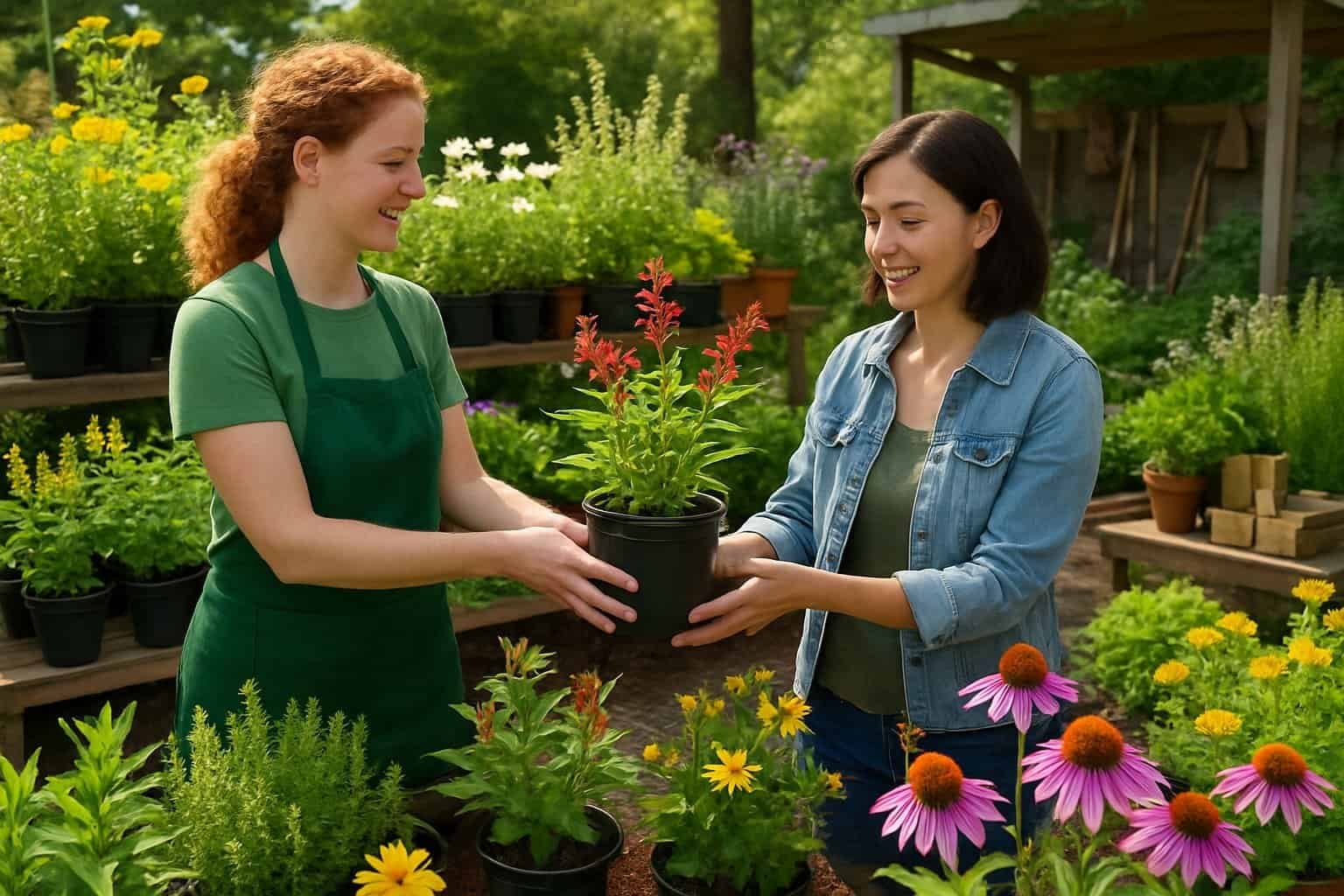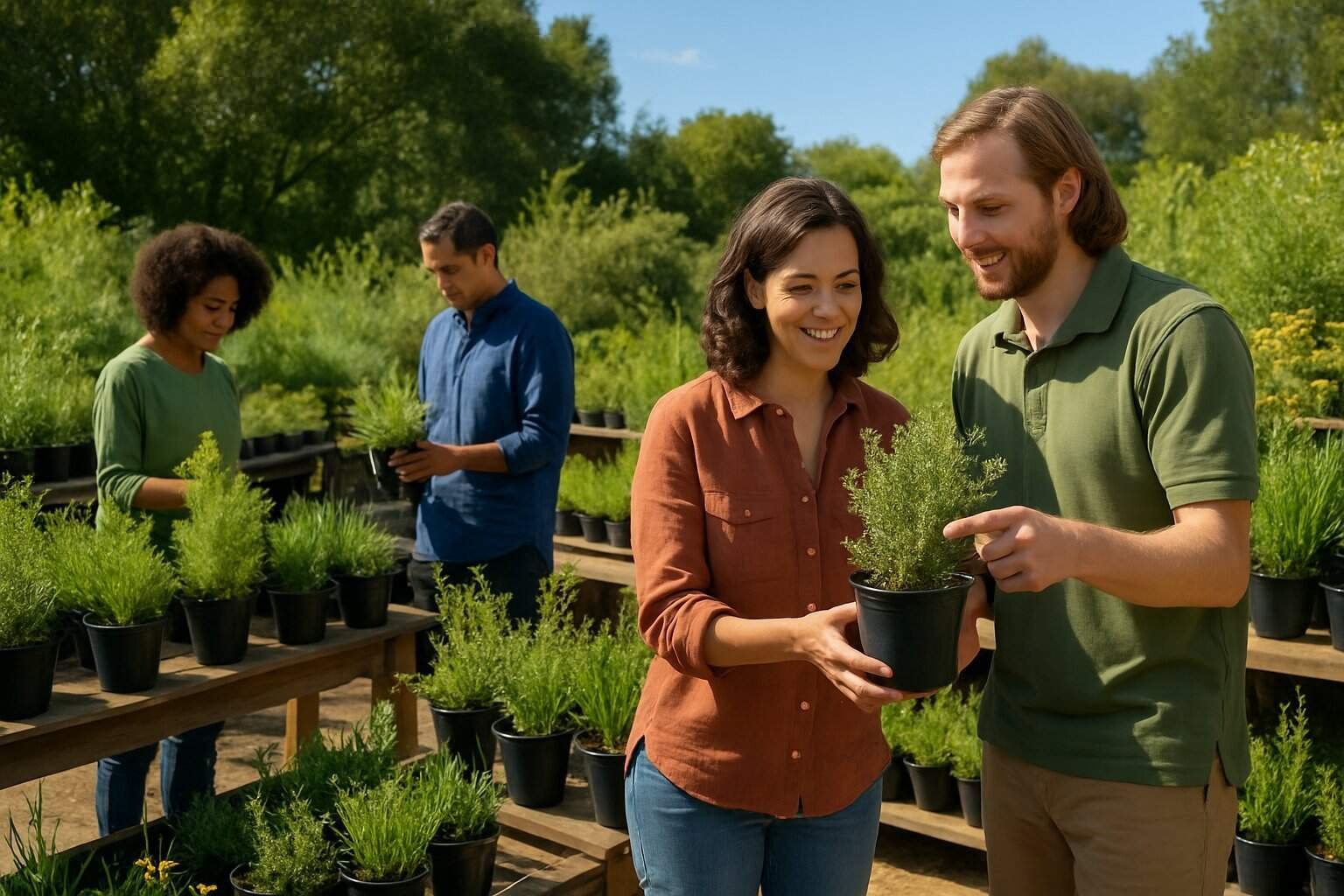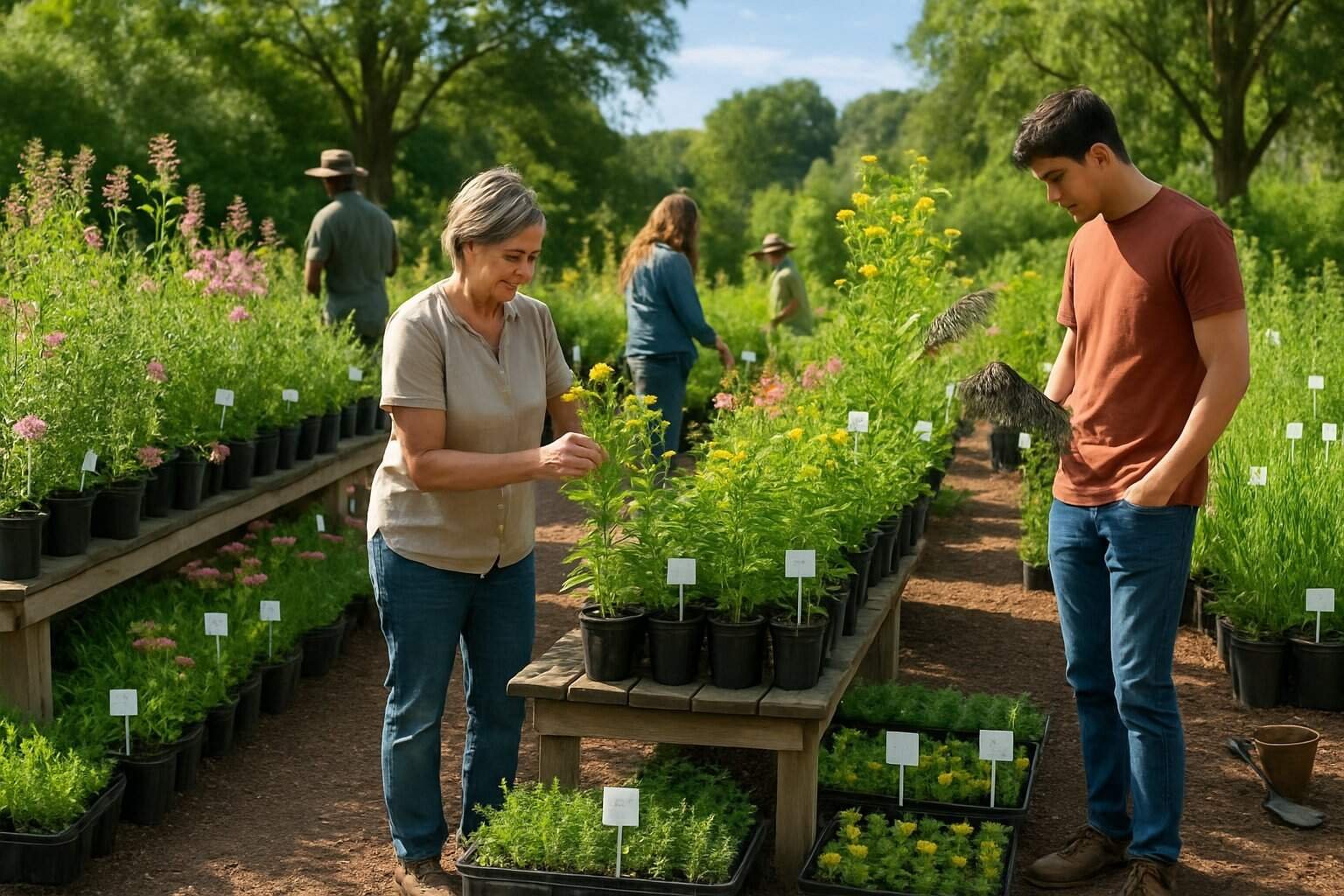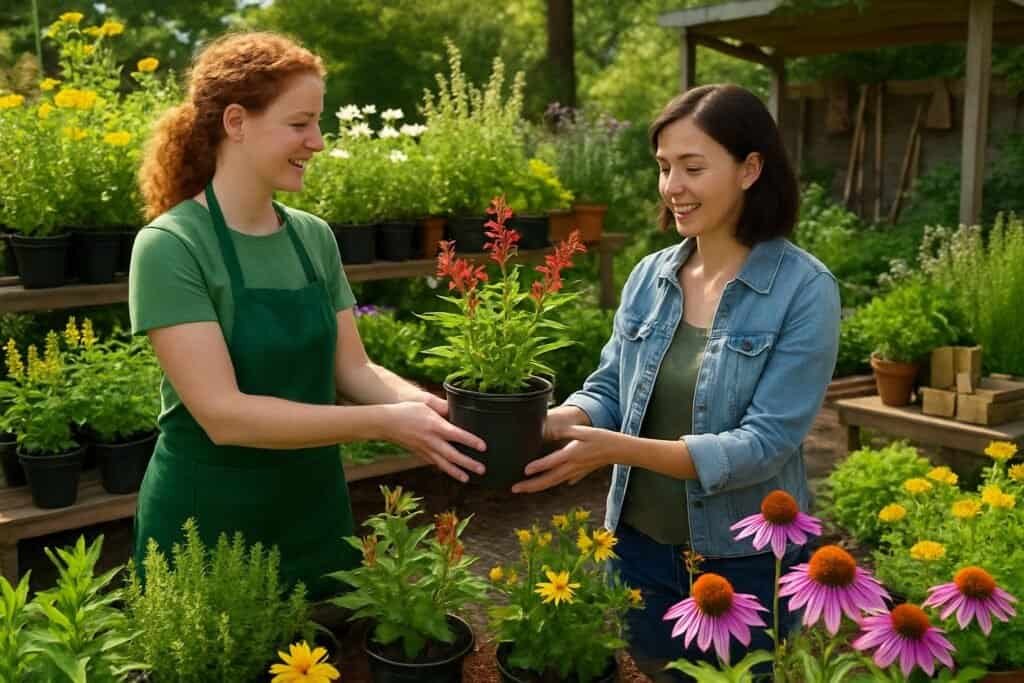Are you looking to bring more local greenery to your yard? Finding native plants that thrive in your area can transform your garden and support local ecosystems.
Native plant nurseries offer species adapted to your local climate. These plants require less water and maintenance and provide better habitat for local wildlife.

Many gardeners don’t realize how accessible native plants have become. Local nurseries, garden centers, and native plant societies now offer impressive selections of regional species.
Some areas even host seasonal native plant sales. You can find rare varieties and get advice from experienced growers at these events.
Key Takeaways
- Native plant nurseries specialize in local species that require less maintenance and support regional wildlife.
- Search for native plant retailers through botanical gardens, conservation organizations, and online directories.
- Choosing plants suited to your specific growing conditions ensures better success and sustainability in your garden.
Understanding Native Plants

Native plants are species that naturally occur in a specific region. They have evolved alongside local wildlife over thousands of years.
These plants form the ecological foundation of natural landscapes. They provide essential habitat for native insects, birds, and other wildlife.
What Are Native Plants
Native plants evolved naturally in a particular region without human introduction. They’ve adapted to local soil, rainfall, and climate over thousands of years.
Unlike non-native species, native plants have complex relationships with local wildlife, insects, and microorganisms.
These plants require less maintenance once established. They’re suited to local conditions and typically need less water, fertilizer, and pest control.
Native plants vary widely across regions. A plant native to California might be invasive in New York.
This regional specificity makes purchasing locally sourced native plants important.
Benefits of Native Species
Native plants provide essential food and habitat for local wildlife, including pollinators like bees and butterflies. Many native insects can only develop on specific native plants.
These plants conserve water with deep root systems that reduce runoff and erosion. They withstand local weather extremes, from droughts to floods, making them resilient in changing conditions.
Native landscapes require fewer resources to maintain. They generally need less water, no fertilizers, and few if any pesticides.
Native plants preserve local biodiversity and natural heritage. They help maintain the distinct character of regional ecosystems.
Key Types: Trees, Shrubs, Grasses, and Perennials
Native Trees form the backbone of local ecosystems. Species like oaks, maples, and pines provide habitat, food, and shelter for countless wildlife.
Many trees serve as keystone species, supporting hundreds of insect species.
Native Shrubs create middle-story habitat in landscapes. Viburnums, serviceberries, and elderberries produce berries for wildlife and provide nesting sites for birds.
These multi-stemmed woody plants often feature attractive flowers, fall color, and winter interest.
Native Grasses develop extensive root systems that build soil health and prevent erosion. Switchgrass, little bluestem, and Indian grass provide seeds for birds and shelter for small mammals.
Native Perennials like coneflowers, asters, and milkweeds support pollinators with nectar and serve as host plants for butterfly caterpillars. They return year after year, creating reliable food sources for wildlife.
How To Find Native Plant Nurseries Near You

Finding places that sell native plants takes some research. These specialized nurseries offer plants that thrive in your local conditions and support local wildlife.
Researching Local Garden Centers
Start by checking garden centers in your area that focus on native plants. Many traditional nurseries now dedicate sections to regional native species.
Call ahead and ask about their native plant selection. Inventory often changes seasonally.
Make a list of garden centers within a 30-mile radius of your home. Check their websites for “native plant” sections or product listings.
Some nurseries specialize exclusively in native plants. Others carry a limited selection.
Local botanical gardens and arboretums often maintain lists of recommended native plant nurseries. These institutions may have gift shops that sell native plants during spring and fall.
Cooperative extension offices can provide information about reputable native plant nurseries in your region. They base their recommendations on scientific knowledge about what belongs in your ecosystem.
Utilizing Native Plant Finder Tools
Several online tools can help you locate native plant nurseries. The Native Plant Finder (www.nwf.org/NativePlantFinder) from the National Wildlife Federation lets you search by zip code for local plants.
State native plant societies maintain directories of nurseries selling indigenous plants. These societies often have websites with searchable databases or downloadable lists.
Apps like iNaturalist can help you identify native plants in your area. Some apps even link directly to nearby suppliers.
Social media groups focused on native gardening share information about local native plant sales and nurseries. Facebook and Reddit communities offer real-time updates.
Visiting Farmers’ Markets and Plant Sales
Seasonal plant sales organized by conservation groups, native plant societies, and botanical gardens offer excellent opportunities to purchase native plants. These events typically happen in spring and fall.
Farmers’ markets increasingly feature vendors selling locally grown native plants. Visit markets during the growing season to find unique native species not available at commercial nurseries.
Native plant sales often include expert advice from knowledgeable volunteers. Bring photos of your garden space to get targeted recommendations.
Mark your calendar for annual native plant sales. Many organizations post their schedules online months in advance.
Choosing the Right Native Plants for Your Region
Selecting native plants that match your location ensures better growth, less maintenance, and greater ecological benefits. Native plants have adapted to local conditions over thousands of years.
Assessing Regional Conditions: Northeast, Midwest, and West
The Northeast region features cold winters and moderate summers. Native plants like Eastern Redbud, New England Aster, and Black-eyed Susan thrive in this climate.
These plants handle seasonal temperature fluctuations well and support local pollinators.
In the Midwest, plants must withstand hot summers and frigid winters. Prairie grasses such as Big Bluestem and Little Bluestem excel here.
Coneflowers, Butterfly Weed, and Blazing Star also perform well in Midwest soils and weather conditions.
The West varies from coastal areas to deserts and mountains. In coastal areas, plants like California Poppy and Ceanothus work well.
Desert regions benefit from Penstemon species and desert sage. Mountain areas support Columbine and various pine species native to higher elevations.
Matching Plants to Local Environments
Soil Type Considerations:
- Sandy soil: Choose drought-tolerant natives like Bearberry or Prairie Dropseed.
- Clay soil: Select moisture-loving plants like Swamp Milkweed or Cardinal Flower.
- Loamy soil: Most natives will thrive, including Woodland Phlox and Wild Geranium.
Light Requirements are important. Full-sun locations need different plants than shady spots.
Sun-loving natives include most prairie plants. Woodland natives like Ferns and Wild Ginger prefer shade.
Water availability should guide plant selection. Some natives require consistent moisture, while others thrive in dry conditions.
This matching reduces watering needs and maintenance costs.
Special Considerations for Massachusetts and Iowa
Massachusetts gardeners should focus on coastal and woodland natives. Plants like Inkberry, Bayberry, and Beach Plum work well in coastal areas.
Inland gardens benefit from Oak-leaf Hydrangea and Massachusetts Fern. The state’s varying soil conditions require careful plant selection.
Iowa’s prairie heritage makes it ideal for tallgrass prairie restoration. Native species like Compass Plant, Prairie Smoke, and the Wild Rose thrive here.
These plants develop deep root systems that handle Iowa’s clay soils and weather extremes.
Both states experience distinct seasons, so choose plants with winter hardiness. Adding spring ephemerals like Bloodroot in Massachusetts or Prairie Violets in Iowa provides early-season interest.
Selecting Native Plants for Different Garden Conditions
Choosing the right native plants depends on understanding your specific garden conditions. The right plant in the right place will thrive with minimal care and support local wildlife.
Native Plants for Partial Shade
Partial shade gardens receive 3-6 hours of direct sunlight daily. These areas offer perfect growing conditions for many native species.
Woodland Phlox (Phlox divaricata) produces delicate blue-purple flowers in spring and forms attractive groundcover. It adapts well to dappled light under trees.
Eastern Columbine (Aquilegia canadensis) features red and yellow blooms that attract hummingbirds. This adaptable plant tolerates various soil types in partial shade.
Virginia Bluebells (Mertensia virginica) display blue bell-shaped flowers in early spring. They go dormant in summer, so plant them with later-emerging species.
Foamflower (Tiarella cordifolia) offers frothy white flower spikes above maple-shaped leaves. It spreads slowly to form colonies in woodland settings.
Plants That Thrive in Clay Soil
Clay soil presents challenges, but many native plants have adapted to these conditions. These species can handle the moisture retention and compaction common in clay soils.
New England Aster (Symphyotrichum novae-angliae) produces vibrant purple flowers in late summer and fall. Its deep roots help break up clay soil and provide food for pollinators.
Joe-Pye Weed (Eutrochium purpureum) grows 4-6 feet tall with mauve flower clusters that butterflies love. It tolerates wet clay conditions well.
Cardinal Flower (Lobelia cardinalis) displays brilliant red blooms that attract hummingbirds. It thrives in moist clay soils.
Swamp Milkweed (Asclepias incarnata) offers pink flower clusters that attract monarch butterflies. It handles clay soil beautifully while providing essential habitat.
Supporting Wildlife and Pollinators with Native Plants
Native plants provide essential food and shelter for local wildlife species. They have evolved alongside these animals, creating relationships that help both plants and animals thrive.
Attracting Bees, Butterflies, and Other Insects
Native flowering plants attract bees, butterflies, and other beneficial insects. These plants produce nectar and pollen that match the needs of local pollinators.
Top pollinator-friendly natives:
- Coneflower (Echinacea)
- Bee balm (Monarda)
- Joe-Pye weed
- Asters
- Black-eyed Susan
Plant these in clusters rather than individually. Insects find food sources more easily when plants grow in groups of 3-5 specimens.
Choose plants with different bloom times to provide food throughout the growing season. Early spring natives like serviceberry feed hungry pollinators, while late-blooming asters offer crucial fall nutrition.
Many native bees are solitary and need bare soil patches for nesting. Leave some areas unmulched to help these important pollinators.
Creating Habitat for Birds and Reptiles
Native plants offer more than beauty. They provide shelter, nesting sites, and food for birds and reptiles.
Dense shrubs like native viburnum and dogwoods protect birds from predators and weather. Their berries supply essential nutrition during migration and winter.
Hummingbirds favor red tubular flowers such as native columbine and cardinal flower. These blooms match the hummingbird’s long bill and high energy needs.
Leave some leaf litter and fallen branches in garden beds. This natural debris creates microhabitats where lizards, toads, and beneficial snakes can hide, hunt, and regulate body temperature.
Native grasses give ground-nesting birds shelter and provide seeds many species rely on. Little bluestem and switchgrass serve as excellent wildlife habitats.
Choosing Host Plants for Keystone Species
Keystone species have outsized impacts on local ecosystems. Adding their host plants to your garden benefits many wildlife species.
Essential host plants:
- Milkweed for monarch butterflies
- Oak trees (support 500+ caterpillar species)
- Native cherries for tiger swallowtails
- Spicebush for spicebush swallowtails
Monarch butterflies can only reproduce on milkweed plants. Without milkweed, their caterpillars cannot survive.
Plant multiple milkweed species for extended bloom times. Oak trees host hundreds of caterpillar species that feed birds raising their young.
A chickadee family needs thousands of caterpillars to raise one brood of nestlings. Leave some stems standing through winter so beneficial insects can overwinter and emerge in spring.
Incorporating Native Plants into Garden Design
Native plants can transform a yard into a thriving, sustainable landscape. They add beauty while supporting wildlife and require less maintenance than exotic species.
Tips for Sustainable Landscaping
Group plants with similar water needs together to conserve resources. This practice, called hydrozoning, uses water efficiently and prevents overwatering.
Consider the mature size of plants to reduce future pruning. Native plants generally need less pruning than non-natives, saving time and reducing yard waste.
Replace parts of your lawn with native groundcovers or meadow plants. These options need less water and mowing and provide habitat for beneficial insects.
Use mulch around native plantings to retain moisture and suppress weeds. Organic mulches like shredded leaves or bark break down gradually and improve soil health.
Install rain gardens with moisture-loving native species to capture runoff from roofs and driveways. These gardens filter pollutants, reduce erosion, and create attractive landscape features.
Combining Native Species for Year-Round Interest
Select plants with different blooming periods for continuous color. Early spring bloomers like redbud trees can be followed by summer coneflowers and fall asters.
Mix plants with varied heights, textures, and forms. Tall grasses add vertical interest, while low-growing sedges create attractive groundcover.
Include native evergreens for winter structure. Plants like inkberry holly or eastern red cedar keep visual appeal when deciduous species lose their leaves.
Choose berry-producing shrubs for wildlife food and winter color. Winterberry holly and American beautyberry display bright fruits when little else shows color.
Native trees with interesting bark or branching patterns add winter appeal. River birch and American sycamore have distinctive bark that stands out in the dormant season.
Making the Most of Your Native Plant Shopping Experience
Shopping for native plants becomes more rewarding when you come prepared. Asking the right questions and verifying plant origins helps ensure you get plants that suit your region.
Questions to Ask at Nurseries
Prepare a list of questions before visiting a native plant nursery. Ask about the growing conditions each plant needs, such as sun or shade, soil type, and water requirements.
Request information about mature size and growth habits to avoid overcrowding your garden.
Ask which plants attract pollinators or provide food for birds. Many nurseries can recommend plant combinations that work well together.
Nursery staff often have valuable experience with local growing conditions. Ask about maintenance requirements and seasonal care tips.
Verifying Local Origins and Authenticity
Not all “native” plants are truly local to your region. Ask the nursery where their plants come from, as those grown from local seed sources usually adapt better.
Look for nurseries that specialize in natives rather than those with only a few token species. Specialized native plant nurseries usually offer better selection and knowledge.
Find out if plants were propagated rather than wild-collected. Ethically sourced plants help protect wild populations.
Check for signs of chemical treatments. Many native plants perform best without pesticide residues that might harm beneficial insects.
Some nurseries provide certification or documentation about their plants’ origins and growing methods.
Frequently Asked Questions
Native plant enthusiasts in California have many options for finding the perfect plants. Local nurseries, online retailers, and community resources offer diverse selections for different regions.
What are the best nurseries to purchase native plants in Southern California?
Southern California has several excellent native plant nurseries. Tree of Life Nursery in San Juan Capistrano specializes in California natives and offers an extensive selection.
Theodore Payne Foundation in Sun Valley provides a nursery and educational resources about native plants.
Las Pilitas Nursery in Santa Margarita carries over 600 species of California natives and provides detailed growing information for each plant.
How can I find native plant nurseries in my area?
The California Native Plant Society (CNPS) maintains a directory of native plant nurseries by region. Their website allows searches by county or zip code.
Local botanical gardens often host native plant sales and can recommend nearby nurseries.
Community gardening groups on social media often share information about local sources for native plants.
Are there online retailers that specialize in native plants for Californian climates?
Several online retailers focus on California native plants. Annie’s Annuals & Perennials ships a wide variety of natives throughout California and provides detailed growing instructions.
Larner Seeds offers native seed packets and plants for many California ecosystems.
High Country Gardens specializes in drought-tolerant natives suitable for California’s Mediterranean climate.
When is the ideal season for planting native species in California?
Fall is generally the best planting time for California natives. October through December allows plants to establish roots during winter rains before summer heat.
Early spring planting also works in many California regions. This gives plants several months to establish before summer drought.
Coastal areas with milder climates offer more flexibility in planting times throughout the year.
Which local nurseries offer the widest selection of California native plants?
Tilden Regional Parks Native Plant Nursery in Berkeley has one of the largest selections of Bay Area natives. They focus on rare and endangered local species.
Matilija Nursery in Moorpark specializes in natives and offers many varieties of manzanitas, ceanothus, and salvias.
Yerba Buena Nursery in Half Moon Bay features over 600 species of California natives in their demonstration gardens and sales area.
How can one obtain California native plants at no cost?
Many CNPS chapters host annual plant exchanges. Gardeners can trade natives at no cost during these events.
These exchanges typically occur in spring and fall.
Local native plant restoration projects give free plants to volunteers. Volunteers help with habitat restoration work.
Seed libraries at community gardens offer free native plant seeds. Some public libraries also provide seeds for home gardening projects.


